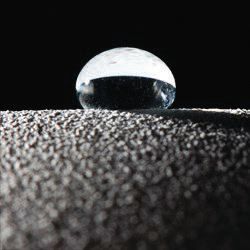Gaining a better understanding of superhydrophobic surfaces
Dr. Neil Canter, Contributing Editor | TLT Tech Beat August 2014
Researchers use a new model involving the impingement of a water jet on a superhydrophobic surface that contains an anisotropic slip.
KEY CONCEPTS
•
Terms such as hydraulic pump and slip are used to characterize the interaction of a superhydrophobic surface with water.
•
A model has been developed that describes the impingement of a water jet on a superhydrophic surface that contains an anisotropic slip.
•
Better drag reduction and a higher slip length (an indirect measure of lower friction) were seen as the water moves parallel to a series of ribs and cavities rather than perpendicular to them.
WATER CONTAMINATION IS ONE OF THE MAIN PROBLEMS faced in operating lubricant systems. Two issues faced are the likelihood of corrosion and premature lubricant failure as water can cause components to decompose, leading to the formation of acidic byproducts.
Superhydrophobic surfaces are under development because they can potentially add an important element to a lubrication system—water repellency. In this column, we have discussed recent research in superhydrophobic surfaces because of the potential for this approach to be an answer to dealing with not only water contamination but also reducing friction and wear.
A recent article indicates that researchers are looking to Mother Nature for direction in developing superhydrophobic surfaces (
1). The wings of a specific butterfly species,
Blue Morpho didius, were found to have a hierarchical scale structure in combination with a hydrophobic wax. This facilitates the reduction of drag while the butterfly is in flight and serves as a self-cleaning mechanism to remove water and hydrophilic contaminants.
Julie Crockett, associate professor of mechanical engineering at Brigham Young University in Provo, Utah, provides a definition for a superhydrophobic surface. She says, “A superhydrophobic surface is characterized by the use of a specific topography containing microscopic ridges and posts in combination with a hydrophobic coating such as polytetrafluoroethylene. Water droplets impact the surface at high contact angles much greater than 120 degrees.”
Figure 2 shows an image of a water droplet beading up on a hydrophobic surface.
 Figure 2. Research is continuing to better understand how water droplets bead up on superhydrophobic surfaces. (Courtesy of Brigham Young University)
Figure 2. Research is continuing to better understand how water droplets bead up on superhydrophobic surfaces. (Courtesy of Brigham Young University)
Crockett and her associate, Daniel Maynes, professor and chair of the department of mechanical engineering at BYU, have studied superhydrophobic surfaces from many different aspects. She says, “We have conducted a lot of different experiments and modeling studies to characterize superhydrophobic surfaces. Our research has looked at how unheated and heated water droplets impinge on and spread on these surfaces. Other work has involved studying the flow of water in a channel where the walls are prepared from superhydrophobic materials. Our objective is to evaluate the hydrodynamic and thermal transport characteristics.”
Maynes adds, “We are basically fluid dynamicists looking at the fundamental behavior of liquids on superhydrophobic surfaces. There are a wide range of phenomena that we are investigating.”
Terms that are used in characterizing the interaction between water and a superhydrophobic surface include hydraulic jump and slip. Hydraulic jump is a transition point where water, after hitting a surface, transitions from a thin to a thick film in a dramatic fashion. Maynes says, “This phenomenon can be seen when we wash dishes. As a jet of water impacts dishes in the sink, a hydraulic jump can be readily observed.” Maynes continues, “Slip is a measure of the velocity of a fluid at a solid surface. In many cases, fluid velocity at the wall is zero, which is characterized as no-slip. In a superhydrophobic surface, fluid velocity at the wall is greater than zero, and a term called slip length is used to determine the amount of slip that occurs.”
Slip is present in a hydrophobic surface due to the presence of air cavities trapped on the surface. Maynes says, “The objective in developing a hydrophobic surface is to find a way to have water rapidly removed. Air pockets are one way to do this because the interaction between air and water leads to low shear stress and, as a consequence, to a drag reduction. In contrast, the direct movement of water on a solid part of the superhydrophobic surface can lead to high shear stress.
ANISOTROPIC SLIP
Crockett and Maynes’ most recent study has been to develop a model that describes the impingement of a water jet on a superhydrophobic surface that contains an anistrophic slip. The model evaluates the slip length as the water moves on a surface where microscopic ribs and cavities have been placed in different orientations.
Crockett says, “We found that better drag reduction and a higher slip length can be found as the water moves parallel to a series of ribs and cavities than perpendicular to them. This is due to the presence of air cavities present along the surface of the ribs and cavities. The shape of the resulting hydraulic jump is altered to be more elliptical.”
Maynes indicates that there is an indirect relationship between slip length and friction. As the slip length increases, the friction observed between the water droplet and the surface declines. Ideally, an infinite slip length will lead to no friction.
In contrast, the slip observed on an isotropic surface where the surface topography is random in all directions was found to be nearly isotropic. Experimental work conducted by Crockett and Maynes agrees quite well with the modeling study.
In the near future, the researchers will be trying to gain a better understanding of thermal transport in applications such as condensation and cooling. Crockett says, “The steam produced in power plants can have a negative effect on the machinery. Our aim is to gain a better understanding of what type of superhydrophobic surface can be developed to better remove water from this environment.”
A future goal is to determine if a change in the engine surface may have a beneficial impact in enhancing the efficiency of automobile engines. Maynes says, “We believe that as diesel fuel is sprayed into the engine, a better piston surface may reduce the amount of wear and friction.”
Further information can be found in a recent article (
2) or by contacting Crockett at
juliecrockett@byu.edu.
REFERENCES
1.
Canter, N. (2014), “Studying butterfly wings to reduce drag,” TLT,
70 (4), pp. 12-13.
2.
Prince. J., Maynes, D. and Crockett, J. (2014), “Jet impingement and the hydraulic jump on horizontal surfaces with anisotropic slip,”
Physics of Fluids,
26, 042104.
 Neil Canter heads his own consulting company, Chemical Solutions, in Willow Grove, Pa. Ideas for Tech Beat items can be sent to him at neilcanter@comcast.net
Neil Canter heads his own consulting company, Chemical Solutions, in Willow Grove, Pa. Ideas for Tech Beat items can be sent to him at neilcanter@comcast.net.